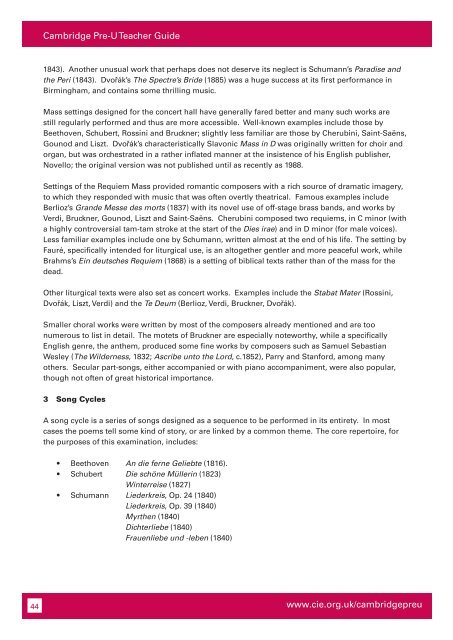Teacher's Guide Cambridge Pre-U MUSIC Available for teaching ...
Teacher's Guide Cambridge Pre-U MUSIC Available for teaching ...
Teacher's Guide Cambridge Pre-U MUSIC Available for teaching ...
Create successful ePaper yourself
Turn your PDF publications into a flip-book with our unique Google optimized e-Paper software.
44<br />
<strong>Cambridge</strong> <strong>Pre</strong>-U Teacher <strong>Guide</strong><br />
1843). Another unusual work that perhaps does not deserve its neglect is Schumann’s Paradise and<br />
the Peri (1843). Dvoák’s The Spectre’s Bride (1885) was a huge success at its first per<strong>for</strong>mance in<br />
Birmingham, and contains some thrilling music.<br />
Mass settings designed <strong>for</strong> the concert hall have generally fared better and many such works are<br />
still regularly per<strong>for</strong>med and thus are more accessible. Well-known examples include those by<br />
Beethoven, Schubert, Rossini and Bruckner; slightly less familiar are those by Cherubini, Saint-Saëns,<br />
Gounod and Liszt. Dvoák’s characteristically Slavonic Mass in D was originally written <strong>for</strong> choir and<br />
organ, but was orchestrated in a rather inflated manner at the insistence of his English publisher,<br />
Novello; the original version was not published until as recently as 1988.<br />
Settings of the Requiem Mass provided romantic composers with a rich source of dramatic imagery,<br />
to which they responded with music that was often overtly theatrical. Famous examples include<br />
Berlioz’s Grande Messe des morts (1837) with its novel use of off-stage brass bands, and works by<br />
Verdi, Bruckner, Gounod, Liszt and Saint-Saëns. Cherubini composed two requiems, in C minor (with<br />
a highly controversial tam-tam stroke at the start of the Dies irae) and in D minor (<strong>for</strong> male voices).<br />
Less familiar examples include one by Schumann, written almost at the end of his life. The setting by<br />
Fauré, specifically intended <strong>for</strong> liturgical use, is an altogether gentler and more peaceful work, while<br />
Brahms’s Ein deutsches Requiem (1868) is a setting of biblical texts rather than of the mass <strong>for</strong> the<br />
dead.<br />
Other liturgical texts were also set as concert works. Examples include the Stabat Mater (Rossini,<br />
Dvoák, Liszt, Verdi) and the Te Deum (Berlioz, Verdi, Bruckner, Dvoák).<br />
Smaller choral works were written by most of the composers already mentioned and are too<br />
numerous to list in detail. The motets of Bruckner are especially noteworthy, while a specifically<br />
English genre, the anthem, produced some fine works by composers such as Samuel Sebastian<br />
Wesley (The Wilderness, 1832; Ascribe unto the Lord, c.1852), Parry and Stan<strong>for</strong>d, among many<br />
others. Secular part-songs, either accompanied or with piano accompaniment, were also popular,<br />
though not often of great historical importance.<br />
3 Song Cycles<br />
A song cycle is a series of songs designed as a sequence to be per<strong>for</strong>med in its entirety. In most<br />
cases the poems tell some kind of story, or are linked by a common theme. The core repertoire, <strong>for</strong><br />
the purposes of this examination, includes:<br />
• Beethoven An die ferne Geliebte (1816).<br />
• Schubert Die schöne Müllerin (1823)<br />
Winterreise (1827)<br />
• Schumann Liederkreis, Op. 24 (1840)<br />
Liederkreis, Op. 39 (1840)<br />
Myrthen (1840)<br />
Dichterliebe (1840)<br />
Frauenliebe und -leben (1840)<br />
www.cie.org.uk/cambridgepreu
















